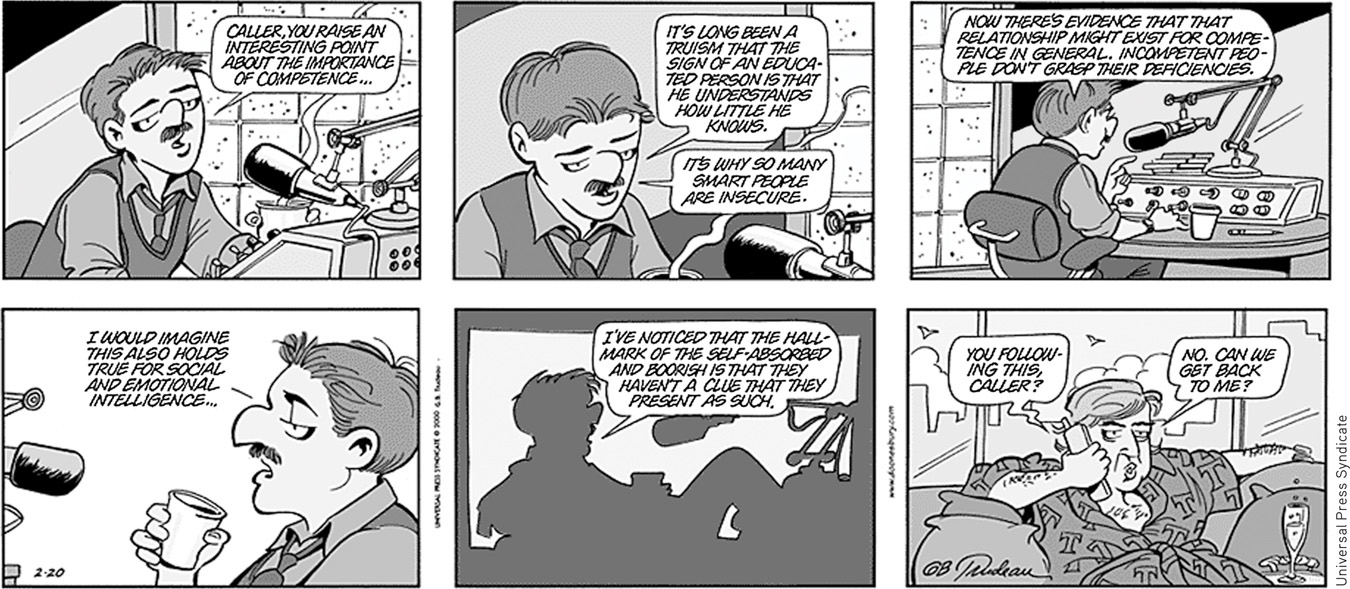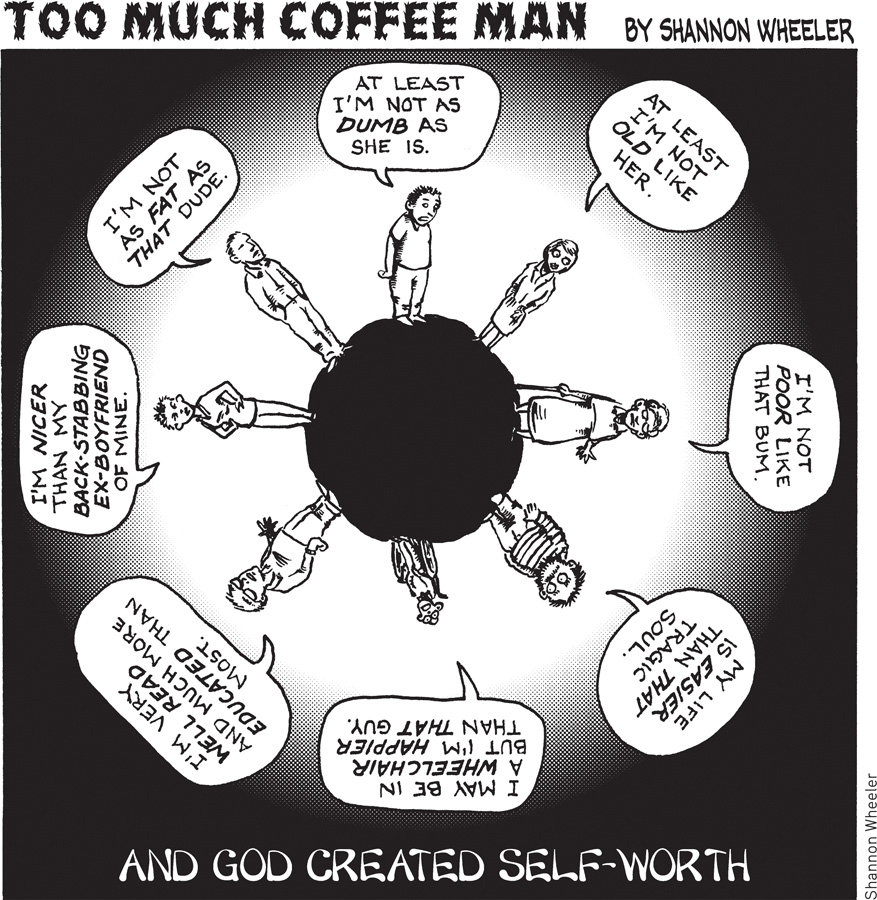Social-Cognitive Theories
social-cognitive perspective views behavior as influenced by the interaction between people’s traits (including their thinking) and their social context.
14-18 How do social-cognitive theorists view personality development, and how do they explore behavior?
Today’s psychological science views individuals as biopsychosocial organisms. The social-cognitive perspective on personality proposed by Albert Bandura (1986, 2006, 2008) emphasizes the interaction of our traits with our situations. Much as nature and nurture always work together, so do individuals and their situations.
reciprocal determinism the interacting influences of behavior, internal cognition, and environment.
Social-cognitive theorists believe we learn many of our behaviors either through conditioning or by observing and imitating others. (That’s the “social” part.) They also emphasize the importance of mental processes: What we think about a situation affects our resulting behavior. (That’s the “cognitive” part.) Instead of focusing solely on how our environment controls us (behaviorism), social-cognitive theorists focus on how we and our environment interact: How do we interpret and respond to external events? How do our schemas, our memories, and our expectations influence our behavior patterns?
Reciprocal Influences
Bandura (1986, 2006) views the person-environment interaction as reciprocal determinism. “Behavior, internal personal factors, and environmental influences,” he said, “all operate as interlocking determinants of each other” (FIGURE 14.5). We can see this interaction in the habits people develop in relationships. For example, Romena’s history of romantic relationships (past behavior) influences her attitudes toward relationships in general (internal factor), which changes how she now responds to Ryan (environmental factor).

 Figure 14.5
Figure 14.5
Reciprocal determinism
Consider three specific ways in which individuals and environments interact:
- Different people choose different environments. The schools we attend, the reading we do, the movies we watch, the music we listen to, the friends we associate with—all are part of an environment we have chosen, based partly on our disposition (Funder, 2009; Ickes et al., 1997). We choose our environment and it then shapes us.
- Our personalities shape how we interpret and react to events. Anxious people tend to attend and react strongly to relationship threats (Campbell & Marshall, 2011). If we perceive the world as threatening, we will watch for threats and be prepared to defend ourselves.
- Our personalities help create situations to which we react. How we view and treat people influences how they then treat us. If we expect that others will not like us, our desperate attempts to seek their approval might cause them to reject us. Depressed people often engage in this excessive reassurance seeking, which confirms their negative self-views (Coyne, 1976a,b).
In addition to the interaction of internal personal factors, the environment, and our behaviors, we also experience gene-environment interaction (Chapter 4). Our genetically influenced traits evoke certain responses from others, which may nudge us in one direction or another. In one classic study, those with the interacting factors of (1) having a specific gene associated with aggression and (2) being raised in a difficult environment were most likely to demonstrate adult antisocial behavior (Caspi et al., 2002).
In such ways, we are both the products and the architects of our environments: Behavior emerges from the interplay of external and internal influences. Boiling water turns an egg hard and a potato soft. A threatening environment turns one person into a hero, another into a scoundrel. Extraverts enjoy greater well-being in an extraverted culture than in an introverted one (Fulmer et al., 2010). At every moment, our behavior is influenced by our biology, our social and cultural experiences, and our cognition and dispositions (FIGURE 14.6).
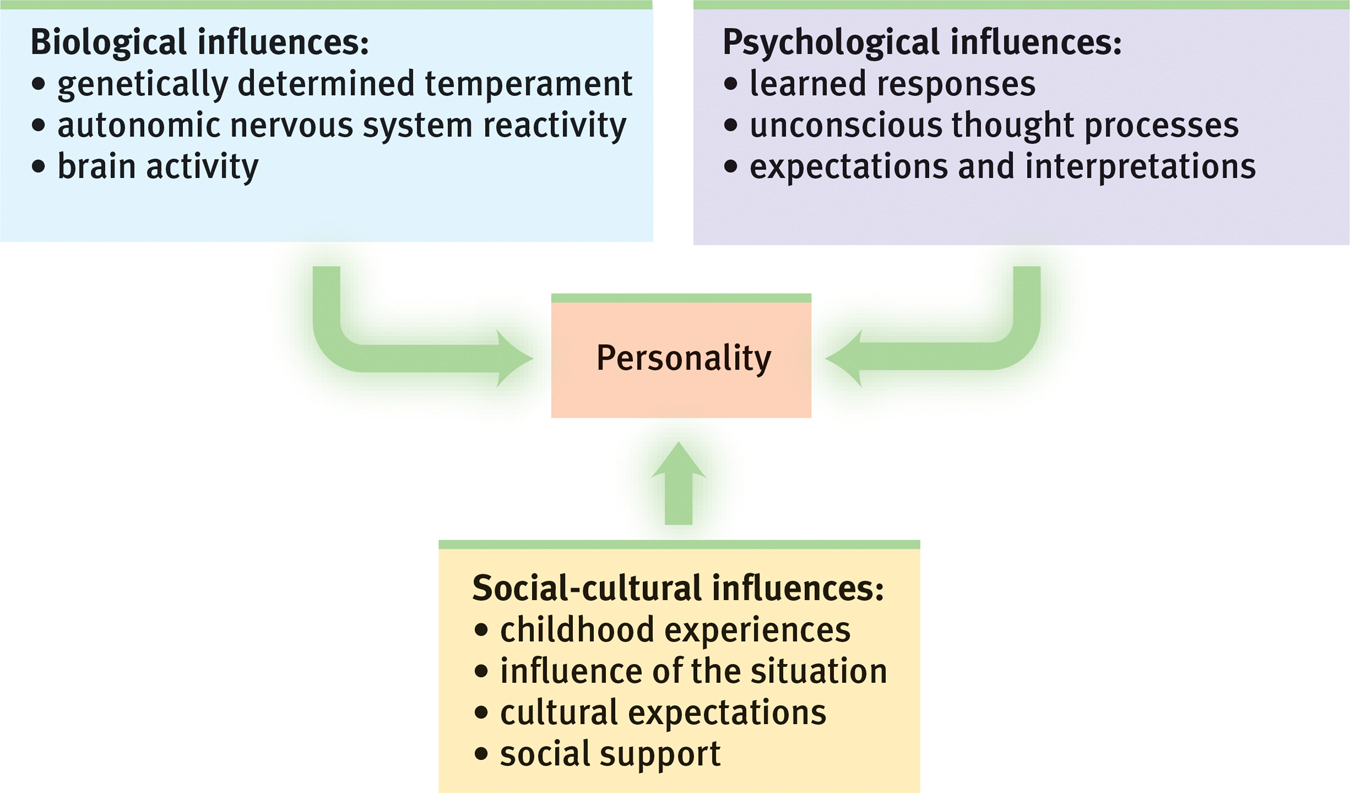
 Figure 14.6
Figure 14.6
The biopsychosocial approach to the study of personality As with other psychological phenomena, personality is fruitfully studied at multiple levels.
RETRIEVAL PRACTICE
- Albert Bandura proposed the ______________ - ______________ perspective on personality, which emphasizes the interaction of people with their environment. To describe the interacting influences of behavior, thoughts, and environment, he used the term ______________ ______________.
social-cognitive; reciprocal determinism
Assessing Behavior in Situations
To predict behavior, social-cognitive psychologists often observe behavior in realistic situations. One ambitious example was the U.S. Army’s World War II strategy for assessing candidates for spy missions. Rather than using paper-and-pencil tests, Army psychologists subjected the candidates to simulated undercover conditions. They tested their ability to handle stress, solve problems, maintain leadership, and withstand intense interrogation without blowing their cover. Although time-consuming and expensive, this assessment of behavior in a realistic situation helped predict later success on actual spy missions (OSS Assessment Staff, 1948). Modern studies indicate that assessment center exercises are more revealing of visible dimensions, such as communication ability, than others, such as inner achievement drive (Bowler & Woehr, 2006).
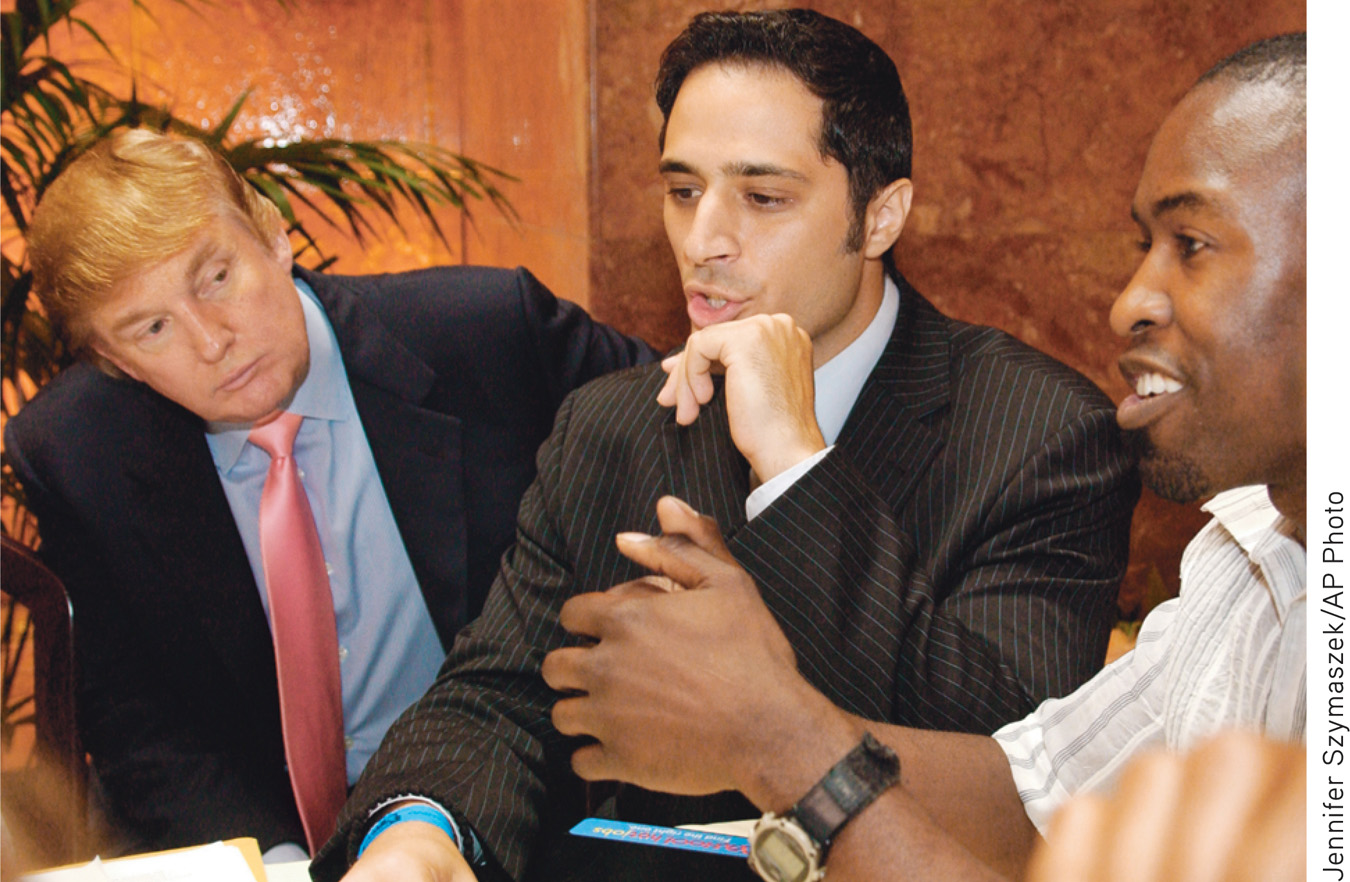
Assessing behavior in situations Reality TV shows, such as Donald Trump’s The Apprentice, may take “show me” job interviews to the extreme, but they do illustrate a valid point. Seeing how a potential employee behaves in a job-relevant situation helps predict job performance.
Military and educational organizations and many Fortune 500 companies have adopted assessment center strategies (Bray et al., 1991, 1997; Eurich et al., 2009). AT&T has observed prospective managers doing simulated managerial work. Many colleges assess students’ potential via internships and student teaching, and assess potential faculty members’ teaching abilities by observing them teach. Most American cities with populations of 50,000 or more have used assessment centers in evaluating police officers and firefighters (Lowry, 1997).
These procedures exploit the principle that the best means of predicting future behavior is neither a personality test nor an interviewer’s intuition. Rather, it is the person’s past behavior patterns in similar situations (Lyons et al., 2011; Mischel, 1981; Schmidt & Hunter, 1998). As long as the situation and the person remain much the same, the best predictor of future job performance is past job performance; the best predictor of future grades is past grades; the best predictor of future aggressiveness is past aggressiveness. If you can’t check the person’s past behavior, the next best thing is to create an assessment situation that simulates the task so you can see how the person handles it (Lievens et al., 2009; Meriac et al., 2008).
“What’s past is prologue.”
William Shakespeare, The Tempest, 1611
Evaluating Social-Cognitive Theories
14-19 What criticisms have social-cognitive theorists faced?
Social-cognitive theories of personality sensitize researchers to how situations affect, and are affected by, individuals. More than other personality theories (see TABLE 14.4), they build from psychological research on learning and cognition.

 Table 14.4
Table 14.4
Comparing the Major Personality Theories
Critics charge that social-cognitive theories focus so much on the situation that they fail to appreciate the person’s inner traits. Where is the person in this view of personality, ask the dissenters, and where are human emotions? True, the situation does guide our behavior. But, say the critics, in many instances our unconscious motives, our emotions, and our pervasive traits shine through. Personality traits have been shown to predict behavior at work, love, and play. Our biologically influenced traits really do matter. Consider Percy Ray Pridgen and Charles Gill. Each faced the same situation: They had jointly won a $90 million lottery jackpot (Harriston, 1993). When Pridgen learned of the winning numbers, he began trembling uncontrollably, huddled with a friend behind a bathroom door while confirming the win, then sobbed. When Gill heard the news, he told his wife and then went to sleep.
Question
o9mevoMNPLJOv4/063YxKDHt9JD+TEIaaa81vHwnJWl+0fKarBgERcK7jvmmx1t6Tuav2JzbQBIiNFtvoNXJLalHaoLLKEiZxCdfWew9eDyNLTNLdX9X+yQDXjP77jxWBpoGi4ydGo4j/b3YArk3tJQmS8GTIv8fACxY1ZgsTDGsQe4bw+xZh1lMNanF2+macipxREUkeafoXHANWwvIzq/k+LUeBGZa0jDgVg==
Possible sample answer: Reciprocal determinism, the cornerstone of Bandura’s social-cognitive theory, refers to the fact that our behavior, internal personal factors, and environmental influences interact. Our behaviors and personal factors (like thoughts and feelings) influence the environments that we choose. Our environments influence personal factors and our behaviors. Personal factors influence our behaviors, and vice versa.
RETRIEVAL PRACTICE
- What is the best way to predict a person’s future behavior?
Examine the person’s past behavior patterns in similar situations.
Exploring the Self
self in contemporary psychology, assumed to be the center of personality, the organizer of our thoughts, feelings, and actions.
14-20 Why has psychology generated so much research on the self? How important is self-esteem to psychology and to human well-being?
Psychology’s concern with people’s sense of self dates back at least to William James, who devoted more than 100 pages of his 1890 Principles of Psychology to the topic. By 1943, Gordon Allport lamented that the self had become “lost to view.” Although humanistic psychology’s later emphasis on the self did not instigate much scientific research, it did help renew the concept of self and keep it alive. Now, more than a century after James, the self is one of Western psychology’s most vigorously researched topics. Every year, new studies galore appear on self-esteem, self-disclosure, self-awareness, self-schemas, self-monitoring, and so forth. Even neuroscientists have searched for the self, by identifying a central frontal lobe region that activates when people respond to self-reflective questions about their traits and dispositions (Damasio, 2010; Mitchell, 2009; Pauly et al., 2013). Underlying this research is an assumption that the self, as organizer of our thoughts, feelings, and actions, is the center of personality.
One example of thinking about self is the concept of possible selves put forth by Hazel Markus and her colleagues (Cross & Markus, 1991; Markus & Nurius, 1986). Your possible selves include your visions of the self you dream of becoming—the rich self, the successful self, the loved and admired self. Your possible selves also include the self you fear becoming—the unemployed self, the academically failed self, the lonely and unpopular self. Possible selves motivate us to lay out specific goals that direct our energy effectively and efficiently (Landau et al., 2014). High school students enrolled in a gifted program for math and science were more likely to become scientists if they had a clear vision of themselves as successful scientists (Buday et al., 2012). Dreams do often give birth to achievements.
“The first step to better times is to imagine them.”
spotlight effect overestimating others’ noticing and evaluating our appearance, performance, and blunders (as if we presume a spotlight shines on us).
Our self-focused perspective may motivate us, but it can also lead us to presume too readily that others are noticing and evaluating us. Thomas Gilovich (1996) demonstrated this spotlight effect by having individual Cornell University students don Barry Manilow T-shirts before entering a room with other students. Feeling self-conscious, the T-shirt wearers guessed that nearly half their peers would take note of the shirt as they walked in. In reality, only 23 percent did. This absence of attention applies not only to our dorky clothes and bad hair but also to our nervousness, irritation, or attraction: Fewer people notice than we presume (Gilovich & Savitsky, 1999). Others are also less aware than we suppose of the variability—the ups and downs—of our appearance and performance (Gilovich et al., 2002). Even after a blunder (setting off a library alarm, showing up in the wrong clothes), we stick out like a sore thumb less than we imagine (Savitsky et al., 2001). To turn down the brightness of the spotlight, we can use two strategies. The first is simply knowing about the spotlight effect. Public speakers who understand that their natural nervousness is not obvious perform better (Savitsky & Gilovich, 2003). The second is to take the audience’s perspective. When we imagine audience members empathizing with our situation, we tend to expect we will not be judged as harshly (Epley et al., 2002).
self-esteem one’s feelings of high or low self-worth.
self-efficacy one’s sense of competence and effectiveness.
The Benefits of Self-Esteem
How we feel about ourselves is also important. High self-esteem—our feelings of self-worth—pays dividends. So also does self-efficacy, our sense of competence on a task. People who feel good about themselves (who strongly agree with self-affirming questionnaire statements such as, “I am fun to be with”) have fewer sleepless nights. They succumb less easily to pressures to conform. They make more positive Facebook posts, causing others to like them more (Forest & Wood, 2012). They are more persistent at difficult tasks; they are less shy, anxious, and lonely. And they are just plain happier (Greenberg, 2008; Orth et al., 2008, 2009). If feeling bad, they think they deserve better and thus make more effort to repair their mood (Wood et al., 2009).
But is high self-esteem the horse or the cart? Is it really “the armor that protects kids” from life’s problems (McKay, 2000)? Some psychologists have their doubts (Baumeister, 2006; Dawes, 1994; Leary, 1999; Seligman, 1994, 2002). Children’s academic self-efficacy—their confidence that they can do well in a subject—predicts school achievement. But general self-image does not (Marsh & Craven, 2006; Swann et al., 2007; Trautwein et al., 2006). Maybe self-esteem simply reflects reality. Maybe it’s a side effect of meeting challenges and surmounting difficulties. Maybe self-esteem is a gauge that reads out the state of our relationships with others. If so, isn’t pushing the gauge artificially higher with empty compliments much like forcing a car’s low fuel gauge to display “full”?
If feeling good follows doing well, then giving praise in the absence of good performance may actually harm people. After receiving weekly self-esteem-boosting messages, struggling students earned lower-than-expected grades (Forsyth et al., 2007). Other research showed that giving people random rewards hurt their productivity. Martin Seligman reported that “when good things occurred that weren’t earned, like nickels coming out of slot machines, it did not increase people’s well-being. It produced helplessness. People gave up and became passive.”
“When kids increase in self-control, their grades go up later. But when kids increase their self-esteem, there is no effect on their grades.”
Angela Duckworth, In Character interview, 2009
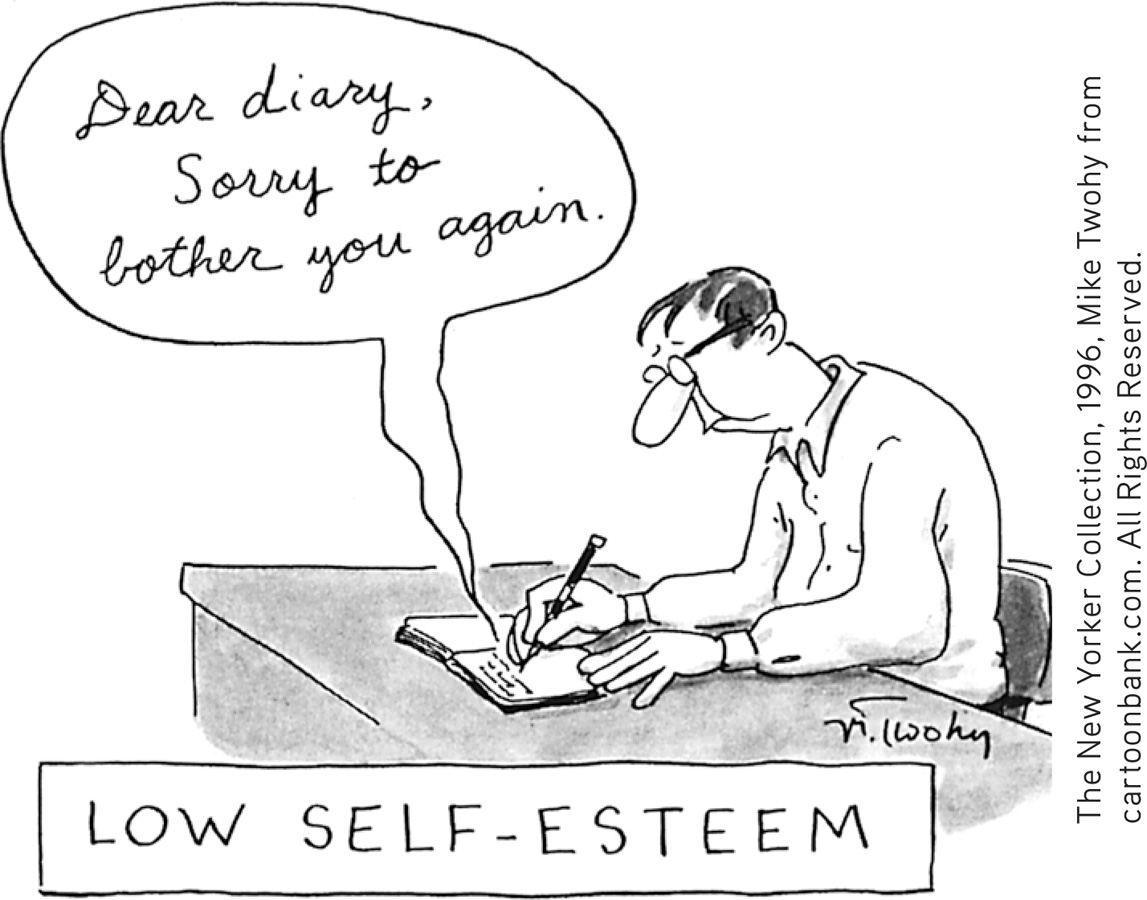
Experiments do reveal an effect of low self-esteem. Temporarily deflate people’s self-image (say, by telling them they did poorly on an aptitude test or by disparaging their personality) and they will be more likely to disparage others or to express heightened racial prejudice (vanDellen et al., 2011; Van Dijk et al., 2011; Ybarra, 1999). Self-image threat even increases unconscious racial bias (Allen & Sherman, 2011). Those who are negative about themselves have also tended to be oversensitive and judgmental (Baumgardner et al., 1989; Pelham, 1993). In experiments, people made to feel insecure have often become excessively critical, as if to impress others with their own brilliance (Amabile, 1983). Self-esteem threats also lead people to gravitate toward their online profiles—safe havens in which to rebuild their self-worth (Toma & Hancock, 2013). Such findings are consistent with humanistic psychology’s presumption that a healthy self-image is essential. Accept yourself and you’ll find it easier to accept others. Disparage yourself and you will be prone to the floccinaucinihilipilification1 of others. Said more simply, some “love their neighbors as themselves”; others loathe their neighbors as themselves. People who are down on themselves tend to be down on others.
Costs of Self-Esteem
14-21 How do excessive optimism, blindness to one’s own incompetence, and self-serving bias reveal the costs of self-esteem, and how do defensive and secure self-esteem differ?
Excessive Optimism Positive thinking in the face of adversity can pay dividends, but so, too, can a dash of realism (Schneider, 2001). Realistic anxiety over possible future failures can fuel energetic efforts to avoid the dreaded fate (Goodhart, 1986; Norem, 2001; Showers, 1992). Concerned about failing an upcoming exam, students may study thoroughly and outperform their equally able but more confident peers. Asian-American students have expressed somewhat greater pessimism than their European-American counterparts, which may help explain their often impressive academic achievements (Chang, 2001). Success requires enough optimism to provide hope and enough pessimism to prevent complacency. We want our airline pilots to be mindful of worst-possible outcomes.
Excessive optimism can blind us to real risks. Neil Weinstein (1980, 1982, 1996) has shown how our natural positive thinking bias can promote “an unrealistic optimism about future life events.” Most college students perceive themselves as less likely than their average classmate to develop drinking problems, drop out of school, have a heart attack by age 40, or go deeply into debt on their high-interest credit cards (Yang et al., 2006). When people entertain positive fantasies about financial success or travel adventure, they often focus on the rewards and ignore the risks (Kappes & Oettingen, 2012). If overconfident of our ability to control an impulse such as the urge to smoke, we are more likely to expose ourselves to temptations—and to fail (Nordgren et al., 2009). Those who optimistically deny the power and effects of smoking, venture into ill-fated relationships, and outwit themselves in dozens of other ways remind us that blind optimism can be self-defeating.
People also display illusory optimism about their groups. Throughout a National Football League season, fans of all teams correctly guessed that other teams would win about 50 percent of their games. But they incorrectly guessed, on average (across teams and weeks), that their own team stood about a 2 in 3 chance of winning (Massey et al., 2011). This optimistic and illogical bias persisted despite their team’s experience and monetary incentives for accuracy.
Our natural positive thinking bias does seem to vanish, however, when we are bracing ourselves for feedback, such as exam results (Carroll et al., 2006). In one analysis of 71 studies, most people shifted their expectations downward shortly before the moment of truth (Sweeny & Krizan, 2013). Positive illusions also vanish after a traumatic personal experience—as they did for victims of a catastrophic California earthquake, who had to give up their illusions of being less vulnerable than others to earthquakes (Helweg-Larsen, 1999).
Blindness to One’s Own Incompetence Ironically, people often are most overconfident when most incompetent. That, say Justin Kruger and David Dunning (1999), is because it often takes competence to recognize competence. They found that most students scoring at the low end of grammar and logic tests believed they had scored in the top half. If you do not know what good grammar is, you may be unaware that your grammar is poor. This “ignorance of one’s own incompetence” phenomenon has a parallel, as I [DM] can confirm, in hard-of-hearing people’s difficulty recognizing their own hearing loss. We’re not so much “in denial” as we are simply unaware of what we don’t hear. If I fail to hear my friend calling my name, the friend notices my inattention. But for me it’s a nonevent. I hear what I hear—which, to me, seems pretty normal.
The difficulty in recognizing one’s own incompetence helps explain why so many low-scoring students are dumbfounded after doing badly on an exam. If you don’t know all the Scrabble word possibilities you’ve overlooked, you may feel pretty smart—until they are pointed out. Our ignorance of what we don’t know sustains our self-confidence, leading us to make the same mistakes (Williams et al., 2013).
To judge one’s competence and predict one’s future performance, it pays to invite others’ assessments, notes Dunning (2006). Based on studies in which both individuals and their acquaintances predict their future, we can hazard some advice: If you’re a junior doctor and want to predict how well you will do on a surgical skills exam, don’t rate yourself—ask your peers for their candid prediction. If you’re a naval officer and need to assess your leadership ability—don’t rate yourself, ask your fellow officers. And if you’re in love and want to predict whether it will last, don’t listen to your heart—ask your roommate.
self-serving bias a readiness to perceive oneself favorably.
Self-Serving Bias Imagine dashing to class, hoping not to miss the first few minutes. But you arrive five minutes late, huffing and puffing. As you sink into your seat, what sorts of thoughts go through your mind? Do you go through a negative door, with thoughts such as, “I hate myself” and “I’m a loser”? Or do you go through a positive door, saying to yourself, “At least I made it to class” and “I really tried to get here on time”?
Personality psychologists have found that most people choose the second door, which leads to positive self-thoughts. We have a good reputation with ourselves. We show a self-serving bias—a readiness to perceive ourselves favorably (Myers, 2010). Consider:
People accept more responsibility for good deeds than for bad, and for successes than for failures. Athletes often privately credit their victories to their own prowess, and their losses to bad breaks, lousy officiating, or the other team’s exceptional performance. Most students who receive poor grades on an exam criticize the exam, not themselves. Drivers filling out insurance forms have explained their accidents in such words as “A pedestrian hit me and went under my car.” The question “What have I done to deserve this?” is one we usually ask of our troubles, not our successes. Although a self-serving bias can lead us to avoid uncomfortable truths, it can also motivate us to approach difficult tasks with confidence instead of despair (Tomaka et al., 1992; von Hippel & Trivers, 2011).
Most people see themselves as better than average. Compared with most other people, how nice are you? How easy to get along with? How appealing are you as a friend or romantic partner? Where would you rank yourself from the 1st to the 99th percentile? Most people put themselves well above the 50th percentile. This better-than-average effect appears for nearly any subjectively assessed and socially desirable behavior:
- In national surveys, most business executives say they are more ethical than their average counterpart. In several studies, 90 percent of business managers and more than 90 percent of college professors also rated their performance as superior to that of their average peer.
- In Australia, 86 percent of people rate their job performance as above average, and only 1 percent as below average.
- In the National Survey of Families and Households, 49 percent of men said they provided half or more of the child care, though only 31 percent of their wives or partners saw things that way (Galinsky et al., 2008).
- Brain scans reveal that the more people judge themselves as better than average, the less brain activation they show in regions that aid careful self-reflection (Beer & Hughes, 2010). It seems our brain’s default setting is to think we are better than others.

The phenomenon, which reflects overestimating the self as well as the desire to maintain a positive self-view (Brown, 2012; Epley & Dunning, 2000), is less striking in Asia, where people value modesty (Falk et al., 2009; Heine & Hamamura, 2007). Yet self-serving biases have been observed worldwide: In every one of 53 countries surveyed, people expressed self-esteem above the midpoint of the most widely used scale (Schmitt & Allik, 2005).
“If you are like most people, then like most people, you don’t know you’re like most people. Science has given us a lot of facts about the average person, and one of the most reliable of these facts is the average person doesn’t see herself as average.”
Daniel Gilbert, Stumbling on Happiness, 2006
Ironically, people even see themselves as more immune than others to self-serving bias (Pronin, 2007). That’s right, people believe they are above average at not believing they are above average. (Isn’t psychology fun?) The world, it seems, is Garrison Keillor’s Lake Wobegon writ large—a place where “all the women are strong, all the men are good-looking, and all the children are above average.”
Self-serving bias flies in the face of pop psychology. “All of us have inferiority complexes,” wrote John Powell (1989, p. 15). “Those who seem not to have such a complex are only pretending.” But additional findings remove any doubts (Guenther & Alicke, 2010; Koudenburg et al., 2011; Myers, 2010):
- We remember and justify our past actions in self-enhancing ways, and exhibit an inflated confidence in our beliefs and judgments. We are quicker to believe flattering descriptions of ourselves than unflattering ones, and we are impressed with psychological tests that make us look good.
- In situations where most people behave less than admirably, we overestimate how desirably we would act. We shore up our self-image by overestimating the commonality of our foibles and by underestimating the commonality of our strengths.
- We see ourselves making better-than-average contributions to our groups (but so do our teammates, which explains why group members’ self-contribution estimates usually total more than 100 percent).
- We exhibit group pride—a tendency to see our group (our school, our country, even our pets) as superior.
Authentic pride that’s rooted in actual achievement supports self-confidence and leadership (Tracy et al., 2009; Williams & DeSteno, 2009). Yet self-serving perceptions underlie conflicts ranging from blaming one’s spouse for marital discord to arrogantly promoting one’s own ethnic superiority. These self-serving tendencies may also explain why people attribute less responsibility for their group’s violent actions (Bilali et al., 2012). Finding their self-esteem threatened, people with large egos may react violently. “Aryan pride” fueled Nazi atrocities. “These biases have the effect of making wars more likely to begin and more difficult to end,” noted Daniel Kahneman and Jonathan Renshon (2007).
“The [self-]portraits that we actually believe, when we are given freedom to voice them, are dramatically more positive than reality can sustain.”
Shelley Taylor, Positive Illusions, 1989
We can see these tendencies even in children, where the recipe for frequent fighting mixes high self-esteem with social rejection. The most aggressive children tend to have high self-regard that gets punctured by other kids’ dislike (van Boxtel et al., 2004). Similarly, an adolescent or adult with a swelled head that gets deflated by an insult is potentially dangerous. Brad Bushman and Roy Baumeister (1998; Bushman et al., 2009) experimented with this “dark side of high self-esteem.” They had 540 undergraduate volunteers write a brief essay, in response to which another supposed student gave them either praise (“Great essay!”) or stinging criticism (“One of the worst essays I have read!”). Then the essay writers played a reaction-time game against the other student. After wins, they could assault their opponent with noise of any intensity for any duration.
Can you anticipate the result? After criticism, those with inflated high self-esteem were “exceptionally aggressive.” They delivered three times the auditory torture of those with normal self-esteem. Threatened egotism, more than low self-esteem, it seems, predisposes aggression. “Encouraging people to feel good about themselves when they haven’t earned it” poses problems, Baumeister (2001) concluded. “Conceited, self-important individuals turn nasty toward those who puncture their bubbles of self-love.”
From 1980 to 2007, popular song lyrics became more self-focused (DeWall et al., 2011). An analysis of 766,513 American books published between 1960 and 2008 showed a similar result: Self-focused words increased (Twenge et al., 2013). On one prominent self-esteem inventory on which 40 is the highest possible self-esteem score, 51 percent of 2008 collegians scored 35 or more (Gentile et al., 2010). Another statistical synopsis—of over 9 million high school seniors and entering college students between 1966 and 2009—also found interest in gaining money, fame, and prestige increasing and concern for others decreasing (Twenge et al., 2012).
“The enthusiastic claims of the self-esteem movement mostly range from fantasy to hogwash. The effects of self-esteem are small, limited, and not all good.”
narcissism excessive self-love and self-absorption.
After tracking self-importance across the last several decades, psychologist Jean Twenge (2006; Twenge & Foster, 2010) reports that what she calls Generation Me expresses more narcissism (by agreeing more often with statements such as, “If I ruled the world, it would be a better place,” or “I think I am a special person”). Agreement with such narcissistic statements correlates with materialism, the desire to be famous, inflated expectations, more hookups with fewer committed relationships, more gambling, and more cheating, all of which have been on the rise as narcissism has increased. Narcissistic people forgive others less, take a game-playing approach to their romantic relationships, and make poor leaders (Campbell et al., 2002; Exline et al., 2004; Nevicka et al., 2011). Hollywood actors and reality television stars—at least those appearing on one national radio show who agreed to take the narcissism test anonymously—are especially narcissistic (Young & Pinsky, 2006). At the collective level, narcissism (sample item: “My group is extraordinary”) predicts increased sensitivity to threats and retaliatory aggression (de Zavala et al., 2009; Lyons et al., 2013).
Despite the demonstrated perils of pride, many people object that the idea of self-serving bias overlooks those who feel worthless and unlovable. If self-serving bias prevails, why do so many people disparage themselves? For four reasons: Sometimes self-directed put-downs are subtly strategic: They elicit reassuring strokes. Saying “No one likes me” may at least elicit “But not everyone has met you!” Other times, such as before a game or an exam, self-disparaging comments prepare us for possible failure. The coach who extols the superior strength of the upcoming opponent makes a loss understandable, a victory noteworthy. A self-disparaging “How could I have been so stupid!” also helps us learn from our mistakes. And finally, self-disparagement also frequently pertains to one’s old self. Asked to remember their really bad behaviors, people recall things from long ago; good behaviors more easily come to mind from their recent past (Escobedo & Adolphs, 2010). People are much more critical of their distant past selves than of their current selves—even when they have not changed (Wilson & Ross, 2001). “At 18, I was a jerk; today I’m more sensitive.” In their own eyes, chumps yesterday, champs today.
“If you compare yourself with others, you may become vain and bitter; for always there will be greater and lesser persons than yourself.”
Max Ehrmann, “Desiderata,” 1927
Even so, it’s true: All of us some of the time, and some of us much of the time, do feel inferior—especially when we compare ourselves with those who are a step or two higher on the ladder of status, looks, income, or ability. For example, Olympians who win silver medals, barely missing gold, show greater sadness on the awards podium compared with the bronze medal winners (Medvec et al., 1995). The deeper and more frequently we have such feelings, the more unhappy, even depressed, we are. But for most people, thinking has a naturally positive bias.
While recognizing the dark side of self-serving bias and self-esteem, some researchers prefer isolating the effects of two types of self-esteem—defensive and secure (Kernis, 2003; Lambird & Mann, 2006; Ryan & Deci, 2004). Defensive self-esteem is fragile. It focuses on sustaining itself, which makes failure and criticism feel threatening. Such egotism exposes one to perceived threats, which feed anger and feelings of vulnerability, notes Jennifer Crocker (2011).
Secure self-esteem is less fragile, because it is less contingent on external evaluations. To feel accepted for who we are, and not for our looks, wealth, or acclaim, relieves pressures to succeed and enables us to focus beyond ourselves. By losing ourselves in relationships and purposes larger than self, Crocker adds, we may achieve a more secure self-esteem, satisfying relationships, and greater quality of life.
Question
pDFchi5fpQrmY/tpMIxMM5Ts+DJL94HDIsmgnWY+h8iSmSYfR37bhHonxCtmdQITSnJvnfxH+7oPb1Rny6lHamsw4d36CavvmghlaHKrzEgMG4pK/JI/1bEuP59cb0gSpUpJrdlf1iKhIZ3xhr0Pu8vdH3LwKA+vkCl/adO7z4Gw6zfQnGdlZCqDERRCmFvabwsbH/eLRC7LXuwvH72A4irjc4qYpXhpO4gf+3akKXyftj6acvlDowdFrcQb9URGBACJFohQMiAWDOrA6QN+qEzvBlowRdW8KejFsH/22+7ekzHUngHJMZ8/Zx7sub50KOQQdknY+JyuaiZc7LHj+pNX14PUm5MuyjMb27/FE/Y=
Possible sample answer: People who have low self-esteem are more likely to be critical of themselves and others. People who have high self-esteem are happier, less likely to give into pressures to conform, less shy, less anxious, and less lonely. The “dark side of high self-esteem” means that when people with high self-esteem have that esteem punctured, they can act out in aggressive ways.
RETRIEVAL PRACTICE
- What are the positive and negative effects of high self-esteem?
People who feel confident in their abilities are often happier, have greater motivation, and are less susceptible to depression. Excessive optimism and very high self-esteem can lead to blindness to one’s own incompetence, self-serving bias, and narcissism.
- The tendency to accept responsibility for success and blame circumstances or bad luck for failures is called ______________ - ______________ ______________.
- ______________ (Secure/Defensive) self-esteem correlates with aggressive and antisocial behavior. ______________ (Secure/Defensive) self-esteem is a healthier self-image that allows us to focus beyond ourselves and enjoy a higher quality of life.

 Figure 14.5
Figure 14.5
 Figure 14.6
Figure 14.6

 Table 14.4
Table 14.4

